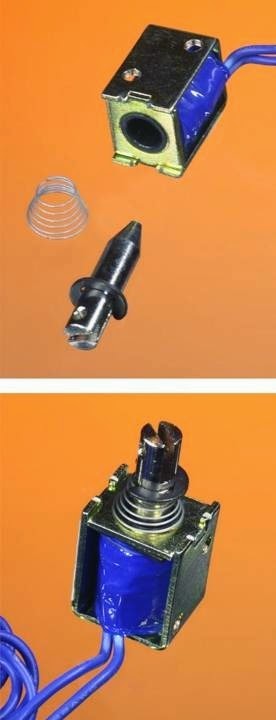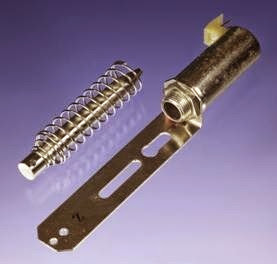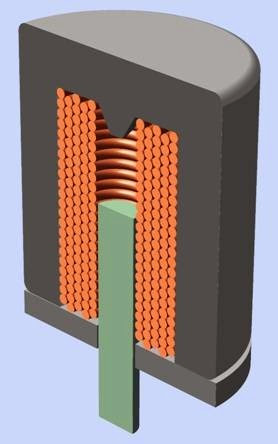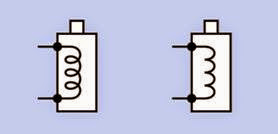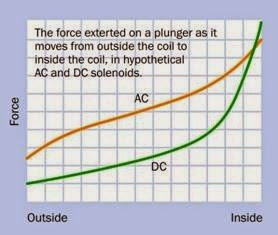The term solenoid was historically used to describe any coil without a magnetic core. More recently and more commonly it describes a coil inside of which a cylindrical plunger moves in response to the magnetic field generated by the coil. In this encyclopedia, the term electromagnet has its own entry, and describes a coil with a center component of ferromagnetic material that does not move relative to the coil. It is used solely to attract or repel other parts that have inherent magnetic properties. By comparison, the inductor entry describes a coil that is used for the specific purpose of creating reactance, or self-inductance, in an electronic circuit, often in association with alternating current and in combination with resistors and/or capacitors. The inductor entry contains a basic discussion and explanation of magnetic force created by electricity.
What It Does
A typical solenoid consists of a hollow coil inside a frame, which may be a sealed cylinder or box- shaped with open sides. In the case of a cylinder, its opposite ends may be referred to as pole faces.
At least one of the pole faces has a hole through which a plunger (also known as an armature) is pulled or pushed by the solenoid. Thus, the solenoid is a device for applying a linear mechanical force in response to current passing through it. In most solenoids, current must be maintained in order to maintain the mechanical force.
A small open-frame solenoid is pictured in Figure 21-1. The upper section of the figure shows the three basic parts: frame, compression spring, and plunger. The lower part of the figure shows the parts assembled.
A larger, closed, cynlindrical solenoid is shown in Figure 21-2, with the plunger and spring re moved.
A 3D rendering showing a simplified, imaginary, cylindrical solenoid cut in half appears in Figure 21-3. The diagram includes a gray cylindrical shell, often described as the frame; the coil, shown in orange; the plunger, which is pulled in to the coil by its magnetic field; and the triangular stop, which limits the plunger’s upward travel. The frame of the solenoid exists not merely to protect the coil, but to provide a magnetic circuit, which is completed through the plunger.
The lower end of the plunger is often fitted with a nonmagnetic yoke or perforated plate for con nection with other components. Stainless steel can be used for this purpose. The stop may be fitted with a thrust rod (also fabricated from stainless steel) if the solenoid is intended to “push” as well as “pull.” Springs to adjust the force of the plunger, or to return it to its initial position when the current through the coil is interrupted, are not shown in the rendering.
Figure 21-1. A small 12VDC solenoid.
Figure 21-2. A larger solenoid rated for 24VDC.
Because there is no standardized schematic symbol for a solenoid, and because this type of component is so widely used in conjunction with valves, any diagram involving solenoids is more likely to emphasize fluid or gas flow with symbols that have been developed for that purpose. In such circuits, a solenoid may be represented simply by a rectangle. However, the symbols shown in Figure 21-4 may occasionally be found.
How It Works
Current flowing through the coil creates a magnetic force. This is explained in the inductor en try of this encyclopedia, using diagrams in Figure 14-3, Figure 14-4, Figure 14-5, and
If the plunger is fabricated from a material such as soft iron, the coil will induce an equal and op posite magnetic polarity in the plunger. Consequently the plunger will attempt to occupy a po sition inside the coil where the ends of the plunger are equal distances from the ends of the coil. If a collar is added to the free end of the plunger, this can increase the pulling force on the plunger when it is near the end of its throw because of the additional magnetic pull distributed be tween the collar and the frame of the solenoid.
Figure 21-3. A simplified view of a solenoid cut in half, showing the primary parts.
Figure 21-4. Although no standard schematic symbol for a solenoid exists, these symbols may sometimes be found.
A spring can be inserted to apply some resistive force to compensate for the increase in pulling
force that occurs as a larger proportion of the plunger enters the coil. A spring may also be used to eject the plunger, partially at least, when cur rent to the coil is interrupted.
If the plunger is a permanent magnet, reversing DC current to the coil will reverse the action of the plunger.
A solenoid with a no magnetized plunger may be energized by AC current, since polarity reversals in the magnetic field generated by the coil will induce equal and opposite reversals in the polarity of the plunger. However, the force curve of an AC-powered solenoid will be different from the force curve of a DC-powered solenoid. See Figure 21-5. The alternating current is likely to induce humming, buzzing, and vibration.
Figure 21-5. A comparison of the force exerted on a plunger, relative to its position as it enters the coil, in hypothetical AC and DC solenoids.
The frame of the solenoid increases the magnetic power that the coil can exert by providing a magnetic circuit of much lower reluctance than that of air (reluctance being the magnetic equivalent of electrical resistance). For a lengthier discussion of this effect, see “Magnetic Core” (page 122) in the inductor entry of this
encyclopedia. If current flowing through the coil increases to the point where the frame becomes magnetically saturated, the pulling power of the solenoid will level off abruptly.
The heat generated by a solenoid when it is maintained in its energized state may be reduced if the manufacturer includes a series resistor and a switch that functions as a bypass switch. The switch is normally closed, but is opened mechanically when the plunger reaches the end of its throw, thus diverting electricity through the series resistor. This itself will generate some heat as a result of the current flowing through it, but by increasing the total resistance of the system, the total heat output will be reduced. The resistor value is chosen to provide the minimum power needed to retain the plunger at the end of its throw.
Variants
The most common variant is tubular, with open- frame as a secondary option. A tubular solenoid has been shown in Figure 21-2.
Additional variants include:
Low Profile
A shorter, fatter solenoid which may be used if a short throw is acceptable.
Latching
A permanent magnet holds the plunger when it reaches the end of its travel, and continues to hold it after power to the solenoid is disconnec ted. The plunger itself is also a permanent mag net, and is released by running current of reverse polarity through the coil.
Rotary
This variant is similar in principle to a brushless DC motor and causes the armature to rotate through a fixed angle (typically ranging from 25
to 90 degrees) instead of moving linearly. It is used as a mechanical indicator in control panels, although it is being displaced by purely elec tronic indicators.
Hinged Clapper
Instead of a plunger, a small hinged panel (the “clapper”) moves in when the solenoid is active, and springs back when the power is interrupted.
Values
The stroke length, duty cycle, and holding force are the most significant values found in solenoid datasheets.
Holding forces for DC solenoids can range from a few grams to hundreds of kilograms. The holding force will be inversely proportional to the length of the solenoid, if all other variables are equal. The force that the solenoid can exert on its plunger also varies depending on the position of the plunger in the length of its throw.
Duty cycle is of special importance because the solenoid continues to draw power and create heat so long as it is holding the plunger at the end of its throw (assuming the solenoid is not the latching type). The initial current surge in an AC solenoid generates additional heat.
The duty cycle is simply calculated. If T1 is the time for which the solenoid is on and T2 is the time for which the solenoid is off, the duty cycle, D, is derived as a percentage from the formula
D = 100 * (T1 / (T1 + T2))
Some solenoids are designed to withstand a 100% duty cycle, but many are not, and in those cases, there is a maximum value not only for D but for the peak “on” time, regardless of the duty cycle. Suppose a solenoid is rated for a 25% duty cycle. If the solenoid is appropriately switched on for one second and off for three seconds, the heat will be allowed to dissipate before it has time to reach overload levels. If the solenoid is switched
on for one minute and off for three minutes, the duty cycle is still 25%, but the heat that may ac cumulate during a one-minute “on” cycle may overload the component before the “off” cycle can allow it to dissipate.
Coil Size vs. Power
Because additional windings in a coil will induce a greater magnetic force, a larger solenoid tends to be more powerful than a smaller solenoid. However this means that if a larger and a smaller solenoid are both designed to generate the same force over the same distance, the smaller sole noid will probably draw more current (and will therefore generate more heat) because of its fewer coil windings.
How to Use it
Solenoids are primarily used to operate valves in fluid and gas circuits. Such circuits are found in laboratory and industrial process control, fuel in jectors, aircraft systems, military applications, medical devices, and space vehicles. Solenoids may also be used in some electronic locks, in pin ball machines, and in robotics.
What Can Go Wrong
Heat
Overheating is the principal concern when using solenoids, especially if the maximum “on” time is exceeded, or the duty cycle is exceeded. If the plunger is prevented from reaching the end of its throw, this can be another cause of overheating.
Because coil resistance increases with heat, a hot solenoid passes less current and therefore de
velops less power. This effect is more pronounced in a DC solenoid than an AC solenoid. A manufacturer’s force curve should show the solenoid performance at its maximum rated temperature, which is typically around 75 degrees Centigrade, in a hypothetical ambient tem perature of 25 degrees Centigrade. Exceeding these values may result in the solenoid failing to perform. As in all coils using magnet wire, there is the risk of excessive heat melting the insulation separating the coil windings, effectively short ening the coil, which will then pass more current, generating more heat.
AC Inrush
When an AC solenoid reaches the end of its travel, the sudden stop of the plunger results in forward EMF that generates additional heat. Generally speaking, a longer stroke creates a greater surge. Rapid cycling will therefore exacerbate coil heating.
Unwanted EMF
Like any device containing a coil, a solenoid creates back EMF when power is connected, and forward EMF when the power is disconnected. A protection diode may be necessary to suppress power spikes that can affect other components.
Loose Plunger
The plunger in many solenoids is not anchored or retained inside the frame and may fall out if the solenoid is tilted or subjected to extreme vibration.

